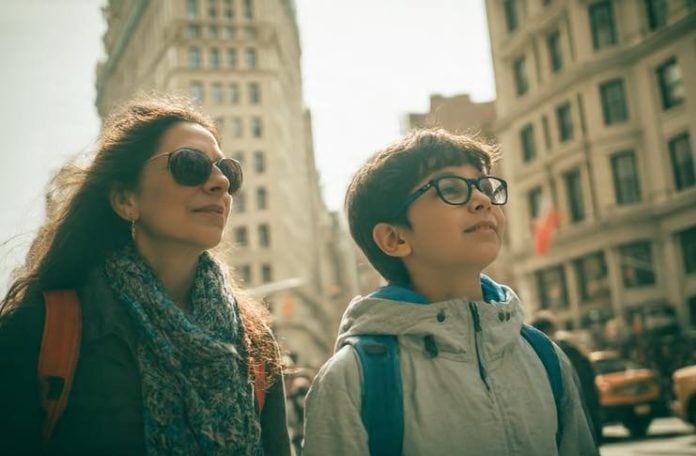New York City is a visual overload, renowned for its vibrant dining scene, spectacular skyline, and non-stop movement. For a child growing up here, the city is one giant, interactive textbook. In such a competitive and visually intense environment, maintaining professionalism in every aspect of a restaurant’s operation isn’t just a matter of pride; it’s essential for success. Professionalism encompasses everything from staff conduct and customer service to kitchen operations, presentation, and business management. For restaurateurs in the city that never sleeps, upholding these standards can differentiate a successful establishment from one that struggles to survive. In this post, as part of our offMetro blog, we’ll explore why early pediatric eye exams are crucial for NYC kids.
Clear vision is essential to a child’s learning and development, yet many vision problems go unnoticed for years. Scheduling a pediatric eye exam early in life helps detect and correct issues before they interfere with reading, coordination, or classroom performance. In Manhattan, where children are surrounded by screens, bright lights, and constant visual stimulation, proper eye care is more important than ever. Clinics like EuroOptica provide comprehensive exams tailored to children’s needs, ensuring healthy vision and confident learning from the start.
Why Early Eye Exams Matter: Seeing the City Clearly
According to the American Optometric Association (AOA), children should have their first full eye exam at 6 months, again at age 3, and before starting first grade, even if no vision issues are visible. About 1 in 4 school-aged children has an undiagnosed vision problem, and early detection can prevent long-term complications.
Common childhood eye issues include:
- Amblyopia (lazy eye) — affects 2–3% of children; early treatment is key.
- Strabismus (eye misalignment) — can cause double vision if untreated.
- Refractive errors — such as nearsightedness, farsightedness, or astigmatism.
- Focusing and tracking problems, which can affect reading fluency and comprehension.
In busy urban environments like Manhattan, where children are exposed to digital screens, fine print, and bright lighting daily, these issues can appear earlier and progress faster. If a child can’t focus clearly, they might miss the wonder of a tiny detail on a landmark, or, more importantly, misjudge a curb while navigating a busy street.
My Experience
I recently took my nephew to see the top of the Empire State Building, but he kept complaining he couldn’t “see the cars clearly” below. I initially dismissed it as being too high, but my friend realized his slight nearsightedness meant he literally couldn’t appreciate the sweeping views of Brooklyn and Queens we were pointing out. It was a clear moment where his developing vision was actively limiting his enjoyment of one of NYC’s best sights.
Check out this video for some tips on taking your kids to the Empire State Building:
Vision and Learning Go Hand-in-Hand: Reading the Environment
Vision isn’t just about clarity—it’s about processing. Research shows that 80% of classroom learning is visual. When a child can’t see the board clearly or struggles to focus on text, their academic confidence and performance can suffer.
New York City educators often see students who are mislabeled as having attention issues when, in fact, the root problem is visual strain or blurred focus. Pediatric optometrists at EuroOptica emphasize early exams as an educational investment, helping children succeed in school and beyond. This processing ability is just as crucial when a kid is trying to rapidly read a subway sign or absorb the massive information panels at the American Museum of Natural History.
My Experience
A friend’s daughter struggled terribly at the Museum of Modern Art (MoMA) because her eyes had difficulty tracking lines on the walls and signs. She was easily overwhelmed by the abstract art and dense crowds. Once she received prescription glasses, her confidence soared; she could actually follow the directional flow of the museum and appreciate the difference between a Jackson Pollock and a Monet.
What Happens During a Pediatric Eye Exam: Low Stress, High Definition
Many parents worry that a child’s first eye exam might be uncomfortable, but at EuroOptica’s Manhattan offices, the experience is calm, interactive, and designed for young patients.
A typical visit includes:
- Visual acuity testing using symbols or picture charts instead of letters for younger children.
- Eye alignment assessment to check for crossed or drifting eyes.
- Focusing and tracking evaluation to ensure the eyes move together smoothly.
- Refraction test to measure for glasses, performed using gentle, child-friendly instruments.
- Ocular health screening with lights and magnification to examine the cornea, lens, and retina.
The clinic’s pediatric optometrists use non-invasive tools and make the exam engaging using games, digital screens, and encouragement to keep kids relaxed and cooperative.
My Experience
My friend described taking her six-year-old to EuroOptica on the Upper West Side after a morning spent exploring the Children’s Museum of Manhattan (CMOM). She loved that the atmosphere was more like a brightly-lit playroom than a doctor’s office. The optician made the tests feel like fun puzzles, ensuring the appointment was less stressful than trying to hail a cab at rush hour!
Check out this review of CMOM to learn more:
Screen Time and Urban Eye Strain: Balancing Pixels and Parks
Children in New York City spend significantly more time on screens than the national average, between 6 to 8 hours per day, according to the American Academy of Pediatrics (AAP). Extended screen exposure increases the risk of digital eye strain and progressive myopia (nearsightedness).
This reliance on screens extends to city travel—reading digital subway schedules, tracking buses on an app, or looking at bright digital billboards in Times Square.
EuroOptica’s doctors frequently recommend:
- The 20-20-20 rule (every 20 minutes, look 20 feet away for 20 seconds).
- Outdoor playtime has been shown to reduce myopia progression.
- Blue-light filtering lenses for kids who use tablets or laptops daily.
These lifestyle adjustments, combined with regular eye exams, help protect children’s vision in Manhattan’s digital world.
My Experience
We often take quick trips out of the city, and I noticed my friend’s kids, who are glued to tablets during the train ride, struggle to focus on the distant scenery when we get off the train. The doctors recommended we swap tablet time for looking for specific birds in Central Park, forcing their eyes to practice focusing on real-world distance instead of just the screen inches from their faces.
Check out this video to see how birding is fun in Central Park:
Choosing the Right Glasses for Kids: Durable for Downtown Adventures
If your child needs corrective lenses, choosing the right pair is both a science and an art. EuroOptica’s boutique optical lab offers durable, flexible frames built for active kids, along with impact-resistant polycarbonate lenses for maximum safety.
Parents can explore frames from trusted brands known for comfort and durability. Every pair is fitted and adjusted by trained opticians to ensure a secure, comfortable fit because a well-fitted frame encourages kids to wear their glasses consistently. Durable frames are especially vital when kids are running through the jungle gym in Washington Square Park or jostling on the Staten Island Ferry.
My Experience
My friend’s son is a little whirlwind who once snapped his glasses trying to climb the lion statues outside the New York Public Library. After replacing them with a more flexible, titanium pair from EuroOptica, they haven’t had a single breakage. It’s an investment in city-kid proof equipment that survives playground tumbles and subway rushes.
Manhattan’s Trusted Pediatric Eye Care Destination
With locations on the Upper East Side and Upper West Side, EuroOptica makes children’s vision care accessible to families across Manhattan. The clinic combines advanced diagnostic technology with a warm, family-friendly atmosphere, so parents can feel confident their child’s eyes are in expert hands.
In a city where visual demands are everywhere, from classroom screens to bright crosswalks, EuroOptica’s pediatric optometrists provide the personalized attention and early intervention that every growing child deserves.
My Experience
As a blogger always rushing between meetings, I value convenience. Having the clinics located near major subway lines—like the UES spot, which is a quick dash from the 77th Street 6 train after visiting the Metropolitan Museum of Art—is huge for city parents. It means they can fit this critical health check into a busy weekend adventure seamlessly.
A Clear Start for a Bright Future
Healthy vision gives children confidence in school, sports, and everyday life. Regular pediatric eye exams are one of the simplest, most effective ways to protect that gift.
If you live in Manhattan and haven’t yet scheduled your child’s first exam, now is the perfect time. At EuroOptica, comprehensive pediatric eye care means early detection, modern technology, and a friendly environment that helps your child see the countless wonders of this incredible city—from the tiny street performers in Union Square to the incredible skyline views—and succeed clearly.










 Sarah Knapp is a
Sarah Knapp is a  Allison was one of our first top writers and Chief Editor but is no longer working with offMetro. Allison is a native New Yorker, who has lived in Rome, Tuscany, Melbourne, Toronto and Los Angeles. She frequently contributed travel pieces to Family Travel Forum, using her own children as guinea pigs as they travel the globe. She never missed a chance to sample local delicacies, as her love for travel goes hand-in-hand with her love for food and wine.
Allison was one of our first top writers and Chief Editor but is no longer working with offMetro. Allison is a native New Yorker, who has lived in Rome, Tuscany, Melbourne, Toronto and Los Angeles. She frequently contributed travel pieces to Family Travel Forum, using her own children as guinea pigs as they travel the globe. She never missed a chance to sample local delicacies, as her love for travel goes hand-in-hand with her love for food and wine.  Josh Laskin is a freelance travel writer and photographer based in the White Mountains of New Hampshire. When he is not at work or on the road, you can find him in the mountains snowboarding, climbing, hiking, fly fishing, mountain biking, and eating bagel bites.
Josh Laskin is a freelance travel writer and photographer based in the White Mountains of New Hampshire. When he is not at work or on the road, you can find him in the mountains snowboarding, climbing, hiking, fly fishing, mountain biking, and eating bagel bites. Annie is a travel writer, environmentalist, and surfer based in Venice, CA. She heads up our West Coast team, keeps our grammatical errors in check, and makes sure our California writers always have a plan for their next
Annie is a travel writer, environmentalist, and surfer based in Venice, CA. She heads up our West Coast team, keeps our grammatical errors in check, and makes sure our California writers always have a plan for their next  Carly Pifer is a freelance writer who has been known to follow whims inspired by romantic movie scenes or colorful street style shots to India, Japan, Tunisia and Argentina. After stints living in Seoul, Boston, Paris and Los Angeles, writing and searching for something intangible, she landed somewhat steadily in Brooklyn and has begun to find inspiration in her more immediate surroundings.
Carly Pifer is a freelance writer who has been known to follow whims inspired by romantic movie scenes or colorful street style shots to India, Japan, Tunisia and Argentina. After stints living in Seoul, Boston, Paris and Los Angeles, writing and searching for something intangible, she landed somewhat steadily in Brooklyn and has begun to find inspiration in her more immediate surroundings.  Kate E. O’Hara is a New York based freelance writer and photographer who loves all things food—especially the people who make it and market it. Her writing aims to capture the essence of the food experience; the stories that go well beyond a plate of ingredients. In addition to her love of food, Kate is also known to have a hankering for red wine and craft beer. You can also find Kate on Instagram
Kate E. O’Hara is a New York based freelance writer and photographer who loves all things food—especially the people who make it and market it. Her writing aims to capture the essence of the food experience; the stories that go well beyond a plate of ingredients. In addition to her love of food, Kate is also known to have a hankering for red wine and craft beer. You can also find Kate on Instagram